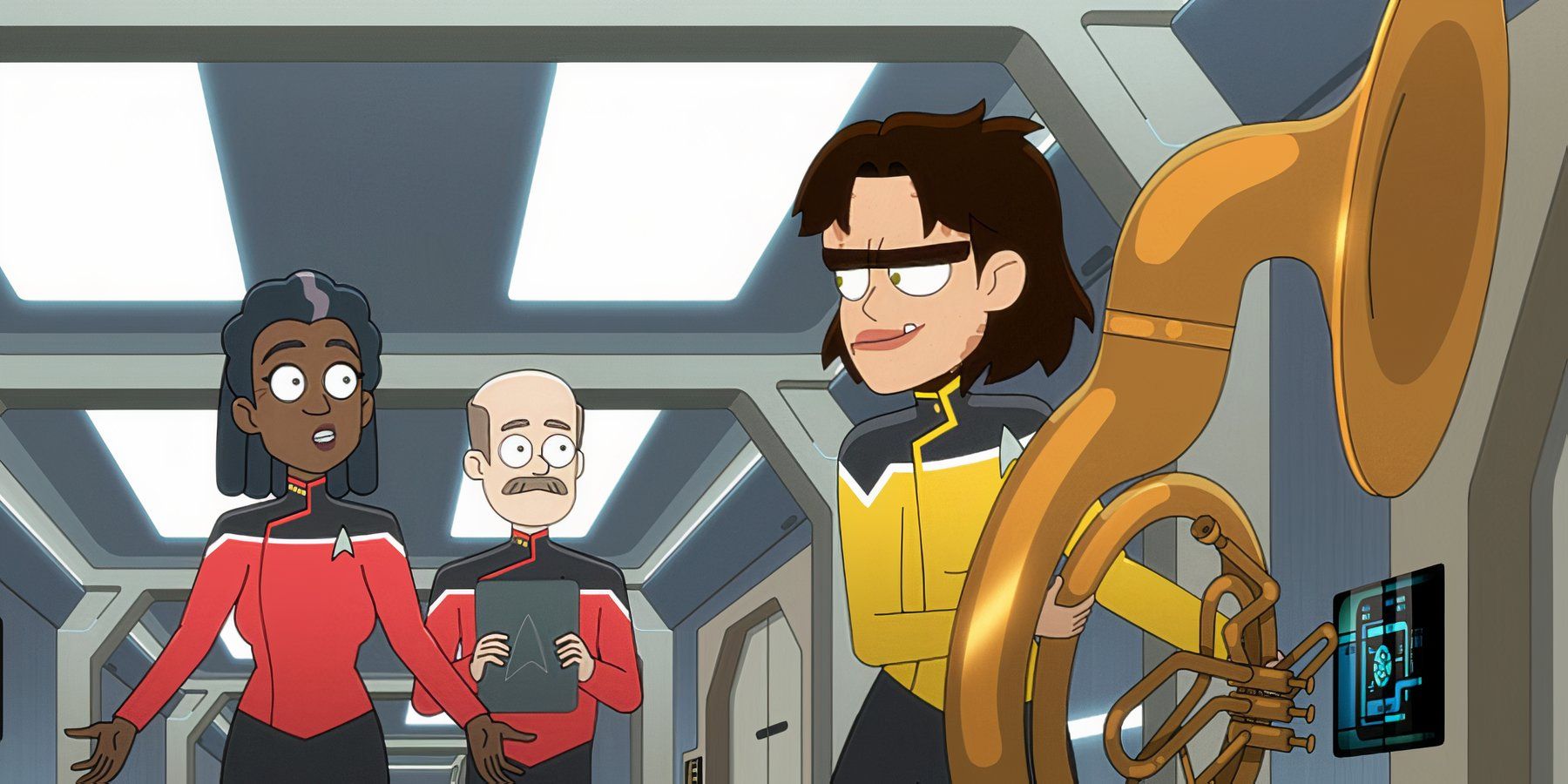Key Takeaways
- Legacy Star Trek shows rarely delved into horror genre unlike modern Trek which is more open to it.
- Star Trek: TNG episode “Genesis” combines body horror with monster mayhem, deviating from typical Trek episodes.
- Lower Decks episode “Upper Decks” pays hilarious homage to “Genesis” with a de-evolution virus subplot.
Though Star Trek is one of the most iconic science-fiction franchises in the history of media, the franchise never played with the horror genre as many sci-fi shows and movies do at some point. This is particularly true of the legacy Star Trek shows. Though modern Trek is much more willing to explore horror, legacy Trek confined its experiments with the genre to a few select episodes.
In Star Trek: The Next Generation, one of those rare horror gems was the seventh season episode “Genesis.” Combining body horror with monster mayhem, the episode goes beyond the typical action horror of the Borg episodes or the psychological horror of episodes like “Frame of Mind” and “Phantasms.” It’s one of the few episodes of Star Trek with genuine jump scares.

Related
Star Trek: Best Episodes For Halloween
Star Trek might not be synonymous with horror, but these episodes are perfect for Halloween.
The latest episode of Star Trek: Lower Decks, “Upper Decks,” paid homage to “Genesis” in classic Lower Decks fashion. Instead of giving fans weird, grotesque body horror, the writers gave them a hilarious Cro-Magnon ensign playing a sousaphone. To put this hilarious tribute in context, here’s a review of “Genesis.”
De-Evolution
The episode starts with Reginald Barclay in sickbay, trying to convince Dr. Beverly Crusher that he has one of several rare diseases. Luckily, this isn’t actually a Barclay episode. Dr. Crusher tells him he has a mild alien flu because the gene that produces immunity in humans isn’t active in his genome. She gives him a hypospray with a specific T-cell in it to activate the immunity gene, and sends him on his way.
Within hours, things start to get weird on the Enterprise-D. Worf is one of the first to exhibit strange behavior. He gets even more aggressive than usual, he’s ravenous all the time, and he’s obsessed with ravaging Counselor Deanna Troi, whom he’s dating. That relationship is one of the subtle horrors of this episode…but that’s another subject.
Shortly after an encounter with Worf, Troi herself begins acting strangely. She’s cold all the time, constantly thirsty, and has a strange desire to take a very hot bath. Soon, Barclay and Commander Riker are both acting strange as well. Barclay acts like he’s set to double speed, while Riker has trouble processing his thoughts and remembering things.
While Deanna lounges in a steamy bath in her quarters, where she’s set the environmental controls to literally tropical, Worf breaks in attacks her, then bites her on the cheek, which avid fans know is how Klingons claim their mates. Troi calls security, and both of them end up in sickbay. Several crew members are there after developing strange physical and behavioral symptoms, and Dr. Crusher concludes that some strange virus is spreading throughout the crew.
When Dr. Crusher examines Worf, she discovers that he’s developed venom sacks under his jaw. When she asks him to open his mouth, he sprays her with a corrosive acid from said venom sacks. Nurse Alyssa Ogawa puts her in a stasis field until they can figure out a cure, and Worf breaks free from sickbay, with a team of security officers in pursuit.
Data and Captain Picard, who have been on a mission off-ship, return and find the Enterprise-D in shambles. As they investigate the damage and search for the missing crew members, they begin to encounter what can only be called monsters. This is where the body horror gets intense. Their tricorders show unidentifiable lifesigns throughout the ship. First, they find Troi, still in her bathtub. She’s transformed into a half-human, half-amphibian. Next, they find Riker, who’s gone full Cro-Magnon.
Data postulates that each crew member is de-evolving into the primordial forms of their species, which is pretty obvious given Riker’s condition. Apparently, Betazoids evolved from amphibians. After analyzing Riker’s DNA, Data discovers that dormant genes in Riker’s genome have been activated.
How the De-Evolution Virus Works
These dormant genes, called introns, were responsible for producing ancient features at previous stages of evolution. When those features disappeared as each species evolved, the genes remained in the genome, but were inactive. Data hypothesized that somehow, all the introns in each crew member’s genome had been activated.
After reviewing the computer’s database, he concludes that the T-cell treatment Dr. Crusher gave Barclay accidentally activated all his introns, not just the dormant gene responsible for immunity to the alien flu. The T-cell replicated, became airborne, and infected the rest of the crew. Data informs Captain Picard that he has also been infected, and it won’t be long until he starts to de-evolve.
In Data’s quarters, they discover that his cat, Spot, has also been affected by the T-cell virus as she is an iguana. However, Spot’s kittens haven’t been affected, which leads Data and Picard to conclude that the placental barrier must have protected them from the virus. Data hypothesizes that human amniotic fluid may provide the same kind of protection, and that he may be able to reverse engineer a cure from a placental sample. For that to work, they need to track down Nurse Ogawa, who had just announced she was pregnant that morning.
Data To The Rescue
On their mission to find Nurse Ogawa and develop the cure, Data and Picard encounter several terrifying creatures. In engineering, they find Barclay, who is now half-human, half spider. In Sickbay, they hear a massive creature outside who begins trying to break in. The tricorder shows that the creature has Klingon DNA.
As Data, who has finally found Nurse Ogawa, begins his research, Worf continues to pound on the sickbay doors. Since Data’s busy, Picard decides to distract Worf and heads into the corridors. The creature he encounters is nothing like Worf. He’s turned into a dinosaur-like creature with a thick exoskeleton and Stegosaurus-like plates all over his head and arms. Picard catches Worf’s attention and leads him on a tense and eerie chase through the Enterprise-D, providing some of the best jump scares of the episode.
Data finally determines that he can produce a cure for the virus from Ogawa’s amniotic fluid and gets to work. Once the antiviral is complete, he releases it through the ship’s air circulation system so it will inoculate the whole crew.
In the end, Barclay jokes about how this was all his fault, and Dr. Crusher informs him that she’ll be naming the virus after him since he was patient zero.
De-Evolution in Lower Decks
In “Upper Decks,” the de-evolution virus isn’t the main plot, but one of many clever Easter egg B-plots. One of the human ensigns aboard the U.S.S. Cerritos contracts a slightly different version of the Barclay virus, though they don’t call it that. In this version of the virus, her body de-evolves into a Cro-Magnon while her mind evolves, giving her super-intelligence and telepathic powers. Hence, her ability to play the sousaphone, even though she’s de-evolved to little more than a caveman.
Though the ensign is on her way to recovery in the episode, she still looks quite prehistoric, and she’s got remnants of her enhanced mental abilities. Both her Cro-Magnon strength and her evolved mind come in handy when the crew has to deal with the alien-of-the-week threat. Though the reference is subtle, as so many of Lower Decks’ Easter eggs are, it’s a delightful homage to “Genesis,” one of Star Trek’s weirder horror episodes.

















Leave a Reply